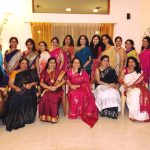This saree has been looking back at me every time I’ve opened my cupboard reminding me it’s her turn
This saree has been looking back at me every time I’ve opened my cupboard reminding me it’s her turn.
A saree my Ma handed over when she was visiting in May. It basically moved from her neat wardrobe downstairs to my messy cupboard upstairs and sat there.
It is the softest cotton, white in self checks, that my mother has hand embroidered. Ma is a crafty woman with her hands if you give her cloth, threads, a needle, a sewing machine, paints, crochet…
As a young girl I remember spending holidays watching her work on a saree that she was creating. My sister and I were roped in to work on small parts after being warned that she expected neat work. ( whole different story ! )
College days were fun dress up time for us because of Ma’s creations. Gurjari cottons turned into customised kurta’s with touches of embroidery or paint, that I see making fashion statements these days.
My Ma has style. Subhadra Maudgal has reinvented herself several times over in her life and is easily the most with it, hip and “youngest” member of our family.
She is eighty and will not sit idle, even when watching television, there is always a project in hand if not a book that she reads against the wall paper audio of a serial. “Nothing new happens for a week in all of them “, she tells us, but still religiously watches her favourites wherever she may be in the world. On her iPad mini if not the television screen.
This saree I remember Ma painstakingly embroider when we lived in Bombay. Over days but only after all her housework was done. She would undo anything that was untidy. Shadow stitch requires detail and precision.
She has these phases of whites and “sparrow coloured” dressing in the midst of bursts of colour. This is a saree she wears when she wants to look her age.
“Anju, I cannot wear rang biranga – colourful, there ! I will wear one of my white sarees.” So she chooses from her white shadow work embroidery saree, or her white saree with crochet border, or a white saree that she has painted on.
I’ve always argued with her when she gets into these phases. She is an elegant lady who can carry off pretty much any colour and I insist she wear more cheerful clothes especially after my father passed away, because she gives in to these bouts of sparrow dressing more often.
Another thing I am always arguing with her about is wearing a bindi which she believes she must not now. I hate that ! My vision of her is incomplete without a bindi, I have seen her wear one everyday of my childhood and later, unless she is in her swish westerns that she adopted on her travels to my siblings, who all live abroad.
My mother has also always, always loved brooches. She collects them wherever she goes, to wear with her sarees. “Sufiana” – sophisticated, she calls them. An influence, I think, from an english lady she met when she was very young.
I wanted to wear this simple saree on the pact as a tribute to her spirit. The saree itself is probably too simple, and plain, to even be considered fashion at all. But to me it is beautiful. It has the meticulous handiwork of a woman I admire and represents all that she always teaches us – that it takes work to build anything of substance. Be it a saree or a life.
Saree # 89 in my mother’s style with a brooch and a bindi. Funked it up with a jacket that I wore as a blouse. Then Meenakshi Gupta came over and we had to take a photo for you, on the balcony, where we almost got blown away. She got me big ‘bindas’ that I wanted

